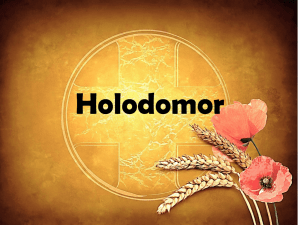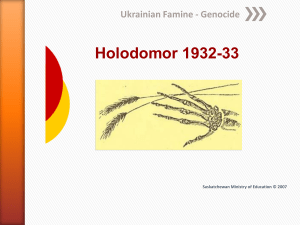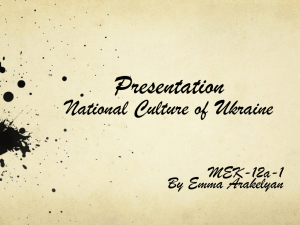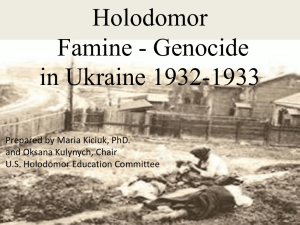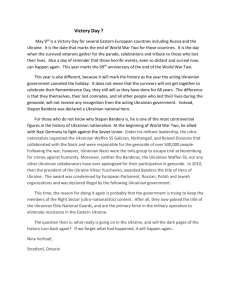- Ukrainian Canadian Congress
advertisement
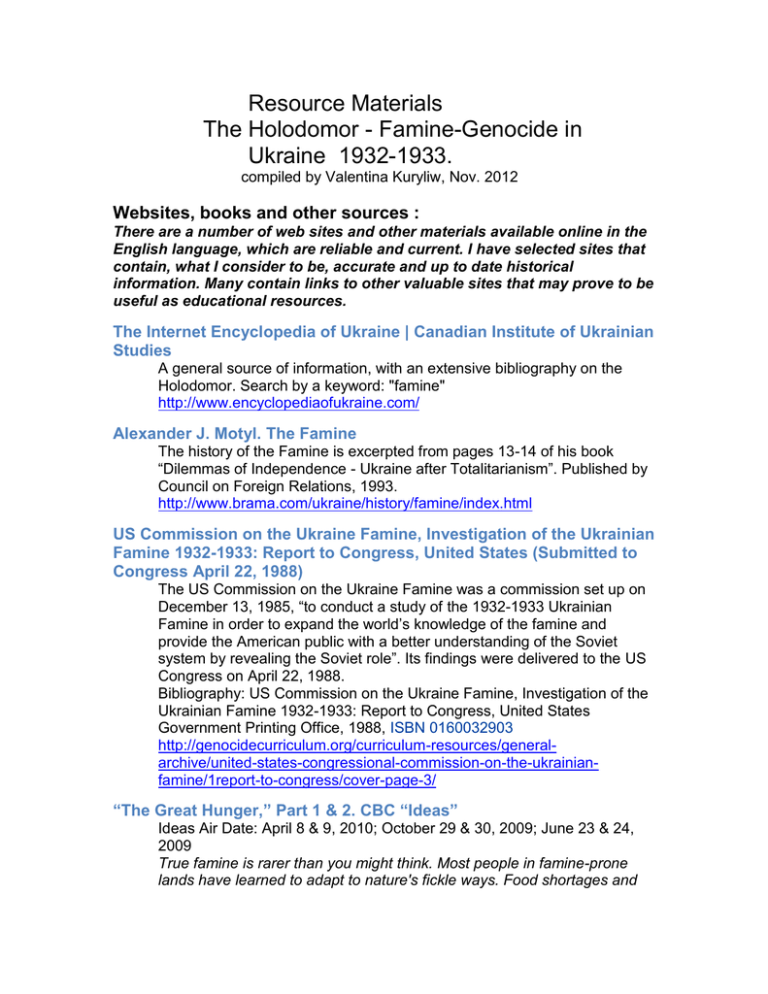
Resource Materials The Holodomor - Famine-Genocide in Ukraine 1932-1933. compiled by Valentina Kuryliw, Nov. 2012 Websites, books and other sources : There are a number of web sites and other materials available online in the English language, which are reliable and current. I have selected sites that contain, what I consider to be, accurate and up to date historical information. Many contain links to other valuable sites that may prove to be useful as educational resources. The Internet Encyclopedia of Ukraine | Canadian Institute of Ukrainian Studies A general source of information, with an extensive bibliography on the Holodomor. Search by a keyword: "famine" http://www.encyclopediaofukraine.com/ Alexander J. Motyl. The Famine The history of the Famine is excerpted from pages 13-14 of his book “Dilemmas of Independence - Ukraine after Totalitarianism”. Published by Council on Foreign Relations, 1993. http://www.brama.com/ukraine/history/famine/index.html US Commission on the Ukraine Famine, Investigation of the Ukrainian Famine 1932-1933: Report to Congress, United States (Submitted to Congress April 22, 1988) The US Commission on the Ukraine Famine was a commission set up on December 13, 1985, “to conduct a study of the 1932-1933 Ukrainian Famine in order to expand the world’s knowledge of the famine and provide the American public with a better understanding of the Soviet system by revealing the Soviet role”. Its findings were delivered to the US Congress on April 22, 1988. Bibliography: US Commission on the Ukraine Famine, Investigation of the Ukrainian Famine 1932-1933: Report to Congress, United States Government Printing Office, 1988, ISBN 0160032903 http://genocidecurriculum.org/curriculum-resources/generalarchive/united-states-congressional-commission-on-the-ukrainianfamine/1report-to-congress/cover-page-3/ “The Great Hunger,” Part 1 & 2. CBC “Ideas” Ideas Air Date: April 8 & 9, 2010; October 29 & 30, 2009; June 23 & 24, 2009 True famine is rarer than you might think. Most people in famine-prone lands have learned to adapt to nature's fickle ways. Food shortages and starvation are more frequently the product of human action: who lives and dies are the results of a brutal calculus of power. Philip Coulter visits Ireland and Ukraine to tell the story of two "famines" that continue to shape these nations today. Listen to Parts 1 and 2. http://www.cbc.ca/ideas/episodes/2010/04/08/the-great-hunger-part-1-2/ Website on Gareth Jones This site presents the findings of Gareth Jones, a British/Welsh journalist, who wrote the truth about the Famine-Genocide in the 1930s and was belittled for his efforts. He was killed under mysterious circumstances. http://www.colley.co.uk/garethjones/ http://www.garethjones.org/ Website “www.faminegenocide.com”, Ukrainian Canadian Congress, Toronto Branch. This site has been compiled to include a variety of short articles, easily read materials, and lesson plans on the Famine-Genocide/The Holodomor of Ukraine, which may be easily used to the classroom. It has an excellent bibliography. http://www.faminegenocide.com/ Website for Ministry of Education of Manitoba on Holodomor Education. Presents rationale, application in Manitoba curriculum and teaching resource sites, for use in Manitoba schools.. http://www.edu.gov.mb.ca/k12/cur/multic/holodomor.html Website “GenocideCurriculum.org” Genocidecurriculum.org is a US-based resource of approved curriculum materials for educators in the private and public sector. It is also a source for a wide array of primary and secondary research materials for advanced study. http://genocidecurriculum.org/curriculum Website “Holodomor: Genocide by Famine” Provides materials for teachers and a link to the 102 poster exhibit “Holodomor Genocide by Famine”. CD of the exhibit is available for purchase. http://www.holodomoreducation.org/ http://www.lucorg.com/block.php/block_id/22 Website “HOLODOMOR 1932-33” The Holodomor.org.uk site is associated with the campaign for UK government to recognize the Holodomor, or genocidal famine, of 1932-33 in Ukraine as genocide. http://www.holodomor.org.uk/ Website “Remember the peasantry” Melnyczuk Morgan, L. (2010). ‘Remember the peasantry’: A study of genocide, famine, and the Stalinist Holodomor in Soviet Ukraine, 1932-33, as it was remembered by post-war immigrants in Western Australia who experienced it (Doctoral thesis). University of Notre Dame Australia, Fremantle, WA. Excellent overview of available research and resources in English. http://researchonline.nd.edu.au/cgi/viewcontent.cgi?article=1054&context=theses Website “Sharing the Story”, Holodomor Survivor Documentation, Ukrainian Canadian Congress Contains interviews with survivors of the Holodomor currently living in Canada. Also provides information and scholarly articles and educational resources. Excellent for primary source on survivors, who were children in 1932-1933 and their memories and accounts of their survival. http://www.holodomorsurvivors.ca/ Wikipedia, the free encyclopedia http://en.wikipedia.org/wiki/Holodomor “The Great Famine in Ukraine: The Holodomor and Its Consequences, 1933 to the Present”. Materials of International Conference sponsored by Ukrainian Research Institute Harvard University, 17–18 November 2008, Harvard University http://www.huri.harvard.edu/na/2008_11_17-18_famine_conf.html Historian Timothy Snyder reflects on this central tragedy of modern history, as he surveys the motives and methods used by both Hitler and Stalin. The interview was conducted by CBC producer Richard Handler. http://podcast.cbc.ca/mp3/ideas_20110221_44873. mp3 The Ukrainian Weekly's collection of materials “THE GREAT FAMINE OF 1932-1933 IN UKRAINE” The Ukrainian Weekly, a newspaper published in the United States by the Ukrainian National Association, has on its website a large collection of materials dedicated to the Great Famine (Holodomor) of 1932-1933 in Ukraine. Located at http://www.ukrweekly.com/archive-txt.htm the special section includes a chronology of the Holodomor years, eyewitness accounts, editorials, media reports, stories about observances of the Ukraine Holodomor 50's Anniversary in 1983, the campaign to revoke Duranty's 1932 Pulitzer Prize, Senate Resolution 202, transcripts of testimony on the Famine commission bill ultimately passed by the U.S. Congress, texts of statements before the U.S. Commission on the Ukraine Famine, references and other documentations, as well as the full text of The Ukrainian Weekly's special issue on the Great Famine (Holodomor) published on March 20, 1983. http://www.ukrweekly.com/old/archive/Great_Famine/index.shtml Website “Infoukes” An information site on things Ukrainian. Articles on the Ukrainian Famine/Genocide and bibliography. http://www.infoukes.com/history/famine/links/ Nicolas Werth. CASE STUDY: The Great Ukrainian Famine of 1932-33 Online Encyclopedia of Mass Violence® - ISSN 1961-9898 - Edited by Jacques Semelin http://www.massviolence.org/The-1932-1933-Great-Famine-in-Ukraine Nicolas Werth. CHRONOLOGICAL INDEX: Mass Crimes under Stalin (1930-1953) (in English) Online Encyclopedia of Mass Violence® - ISSN 1961-9898 - Edited by Jacques Semelin http://www.massviolence.org/Mass-crimes-under-Stalin-1930-1953 Nicolas Werth. CHRONOLOGICAL INDEX: Les crimes de masse sous Staline (1930-1953) (in French) Online Encyclopedia of Mass Violence® - ISSN 1961-9898 - Edited by Jacques Semelin http://www.massviolence.org/Les-crimes-de-masse-sous-Staline-19301953 James Perloff. “Holodomor: The Secret Holocaust in Ukraine” Online “The New American Magazine” http://www.thenewamerican.com/index.php/history/european/761 Library of Congress's Revelations from the Russian Archives: Ukrainian Famine http://www.loc.gov/exhibits/archives/ukra.html Website “Historywiz.com” HistoryWiz is for students, teachers, and lovers of history. It presents a section on the Ukraine Famine http://www.historywiz.com/ukrainefamine.htm Website “preventgenocideinternational” This website is a global education and action network for the prevention of genocide and crimes against humanity. It presents a section “USSR 19321934: Soviet Genocide/Famine in Ukraine (Holodomor)” http://www.preventgenocide.org/edu/pastgenocides/soviet/ukraine/resourc es// Webpage on Holodomor of the Australian Federation of Ukrainian Organisations Provides audio, video, survivor transcripts. http://www.theage.com.au/multimedia/ukrainefamine/main.html Ukrainian Genocide Famine Foundation - USA Extensive educational material available for teachers on the Ukrainian Genocide, including information with eyewitness accounts, media coverup, bibliography and lesson plans. http://www.UkrainianGenocide.org Dr. Robert Conquest’s talk, “Ukraine 1933: The Terror Famine”, November 7, 1995 The United States Holocaust Memorial Museum website presents transcripts of lectures in its SPEAKER SERIES, “Genocide and Mass Murder in the Twentieth Century: A Historical Perspective” — a series of lectures on a number of the major genocidal events of the 20th century, providing a historical perspective and addressing some of the most vital issues facing the field of genocide studies. Lecture topics included: genocide, Armenia, the Ukraine famine, Rwanda and Burundi, the Holocaust, China, and rescuing endangered peoples. http://www.ushmm.org/genocide/analysis/details.php?content=1995-10-24 Website www.ArtUkraine.com Website www.ArtUkraine.com introduces the advancement of Ukrainian arts, culture, history and heritage to the English-speaking audience. The Genocide Gallery presents how the Famine-Genocide is depicted through art. Bibliography. http://www.artukraine.com/index.php?do=cat&category=genocide Research Centres and programs, University level Center for the Study of Genocide, Conflict Resolution, and Human Rights Rutgers, The State University of New Jersey. The Center for the Study of Genocide, Conflict Resolution, and Human Rights at seeks to enhance our understanding of genocide, political violence, and protracted conflict and related mechanisms for their prevention and resolution. To this end, the Center promotes cutting-edge research and scholarship, educational initiatives, workshops and seminars, outreach and commemorative programs, and international collaborations related to genocide, conflict resolution, and human rights. http://cghr.newark.rutgers.edu/ It also provides a list of educational websites on the Study of Genocide, Conflict Resolution, and Human Rights: http://cghr.newark.rutgers.edu/education_resources.html The Genocide Studies Program, Yale University It conducts research, seminars and conferences on comparative, interdisciplinary, and policy issues relating to the phenomenon of genocide, and has provided training to researchers from afflicted regions. http://www.yale.edu/gsp/index.html Soviet Man-Made Famine in Ukraine by James Mace: Chapter in Century of Genocide: Critical Essays and Eyewitness Accounts. ed. Samuel Totten, William S. Parsons and Israel W. Chaney: pp.78-112, 1997,ed: pp.93-124, 2nd. ed. 2004; also in 3rd.ed. http://www.faminegenocide.com/commemoration/mace_ch3.html Books: Cawthorne, Nigel, The Crimes of Stalin: The Murderous Career of the Red Tsar. Arcturus Publishing Ltd., London, 2011. Chorbajian, L., Shrinian, G., Studies in Comparative Genocide. Palgrave Macmillan, 1999. ( The chapter: “The Ukrainian Famine of 1932-33 by Frank Sysyn is recommended reading.) Colley M.S., Colley, N.L, “ More Than a Grain of Truth, The Biography of Gareth Richard Vaughan Jones. Nottingham, England, 2005. Conquest, R., Harvest of Sorrow: Soviet Collectivization and the Terror Famine. . Oxford University Press, 1987. Dimarov, A., Hutsalo, Y., Zvychayna. O., A Hunger Most Cruel: The Human Face of the 1932-1933 Terror-Famine in Soviet Ukraine. Language Lantern Publications, 2002. (Short stories on the Famine-Genocide suitable for students.) Dolot, M., Execution by Hunger: The Hidden Holocaust. W/W. Norton & Company, 1987. Hetman, D, Yukhnovskiy, The Holodomor 1932-1933: Genocide Against the Ukrainian People. Ukrainian Institute of National Memory, Olena Teliha Publishers, Kyiv, 2008. A visual presentation of the Holodomor through an exhibit of posters on the Holodomor in a large booklet format, suitable for students. Photos and documents from various archives of Ukraine. Isajiw, V.W., ed. , Famine-Genocide in Ukraine 1932-1933: Western Archives, Testimonies and Research. Basilian Press, Toronto, 2003. Ivshyna, L., ed., Day and Eternity of James Mace. Ukrainian Press Group Ltd., Kyiv, 2005. American historian who put the study of the Ukrainian Genocide on the world arena. Kardinalowska, Tatiana. The Ever-Present Past. The Memoirs of Tatiana Kardinlowska. Tatiana Kardinalowska’s Ever-Present Past is an exceptional and extremely readable testimony of the cataclysmic times she witnessed—the Ukrainian Revolution, the subsequent civil war and Ukrainian-Soviet War, and the first fifteen years of Bolshevik rule in Ukraine, including the periods of Ukrainization and then Stalinist terror. The daughter of a tsarist general, Kardinalowska (1899– 1993) survived the terror of the 1930s and the Second World War and became a postwar refugee in the United States. https://ciuspress.com/catalogue/memoir-and-biography/84/the-ever-present-past Klid, Bohdan, Motyl, Alexander. Holodomor Reader: A Sourcebook on the Famine of 1932-1933 in Ukraine, Canadian Institute of Ukrainian Studies Press, Toronto, 2012. The Holodomor Reader is a wide-ranging collection of key texts and source materials, many of which have never before appeared in English, on the genocidal famine (Holodomor) of 1932-33 in Soviet Ukraine. The subject is introduced in an extensive interpretive essay, and the material is presented in six sections: scholarship; legal assessments, findings, and resolutions; eyewitness accounts and memoirs; survivor testimonies, memoirs, diaries, and letters; Soviet, Ukrainian, British, German, Italian, and Polish documents; and works of literature. Each section is prefaced with introductory remarks describing the contents. The book also contains a guide to further reading and a map. Besides turning a spotlight on this human catastrophe, whose magnitude did not become generally apparent until the Soviet collapse, this book presents ample evidence that the Holodomor was a genocide perpetrated by Joseph Stalin and his henchmen. The Reader is an indispensable guide for all those interested in the Holodomor, genocide, or Stalinism. http://www.ciuspress.com/catalogue/history/324/the-holodomorreader Krawchenko, Bohdan, Serbyn, Roman. Famine in Ukraine, 1932–1933 The Soviet Man-made famine of 1932–3 in Ukraine claimed the lives of millions of people, yet until recently it has remained veiled in obscurity. This pioneering volume, which appeared before the publication of Robert Conquest's Harvest of Sorrow and the establishment of the US Congressional Committee on the Famine, was one of the first scholarly efforts to analyze the famine. Chapters include: The Man-Made Famine of 1933 in Soviet Ukraine; The Man-Made Famine of 1932–1933 and Collectivization in Soviet Ukraine; Ukraine's Demographic Losses 1921–1938; The Famine of 1933: A survey of the Sources, Making the News Fit to Print: Walter Duranty, the New York Times and the Ukrainian Famine of 1933; Russian Mensheviks and the Famine of 1933; Blind Eye to Murder: Britain, the United States and the Ukrainian Famine of 1933; The Impact of the Man-made Famine on the Structure of Ukrainian Society; The Famine of 1921–1923: A Model for 1932–1933?; Conceptualizations of Genocide and Ethnocide. Order from the CIUS PRESS: http://www.ciuspress.com/catalogue/history/18/famine-in-ukraine%2C1932%2D1933 Kuromiya, H., The Voices of the Dead: Stalin’s Great Terror in the 1930s, Yale University Press, Dec. 2007. Luciuk, Lubomyr, ed., Holodomor: Reflections on the Great Famine of 1932-1933 in Soviet Ukraine. Kashtan Press, 2008. .Luciuk, Lubomyr Not Worthy: Walter Duranty’s Pulitzer Prize and the New York Times, Kashtan Press, 2004. (Media cover-up) Mace, James., Communism and the Dilemma of National Liberation: National Communism in Soviet Ukraine 1918-1933. Cambridge, Mass., 1983. Mace, James. “I Was Chosen by Your Dead”, The Day (Kyiv), Feb.18, 2003. Mak, Olha, Stones Under the Scythe. trans. by Vera Kaczmarskyj, iUniverse Inc., Bloomington, 2011. Suitable young adult novel on the Holodomor in Kharkiv. Marples, David., Heroes and Villains: Creating National History in Contemporary Ukraine. Central European University Press, 2008. Martin, T., The Affirmative Action Empire: Nations and Nationalism in the Soviet Union, 1923-1939. McVay, Athanasius D. and Luciuk, Lubomyr, ed. ,The Holy See and the Holodomor : documents from the Vatican Secret Archives on the Great Famine of 1932-1933 in Soviet Ukraine. Kingston, Ontario; Kashtan Press, 2011. Translated from the Italian. Naimark, Norman M., Stalin’s Genocides, Princeton University Press, Princeton, 2010. Between the early 1930s and his death in 1953, Joseph Stalin had more than a million of his own citizens executed. Millions more fell victim to forced labor, deportation, famine, bloody massacres, and detention and interrogation by Stalin's henchmen. Stalin's Genocides is the chilling story of these crimes. The book puts forward the important argument that brutal mass killings under Stalin in the 1930s were indeed acts of genocide and that the Soviet dictator himself was behind them. Norman Naimark, one of our most respected authorities on the Soviet era, challenges the widely held notion that Stalin's crimes do not constitute genocide, which the United Nations defines as the premeditated killing of a group of people because of their race, religion, or inherent national qualities. In this gripping book, Naimark explains how Stalin became a pitiless mass killer. He looks at the most consequential and harrowing episodes of Stalin's systematic destruction of his own populace--the liquidation and repression of the so-called kulaks, the Ukrainian famine, the purge of nationalities, and the Great Terror--and examines them in light of other genocides in history. In addition, Naimark compares Stalin's crimes with those of the most notorious genocidal killer of them all, Adolf Hitler. http://press.princeton.edu/titles/9278.html Pyrih, Ruslan. ed., Holodomor of 1932-33 in Ukraine: Documents and Materials. National Academy of Sciences of Ukraine, Institute of History of Ukraine, Ministry of Foreign Affairs of Ukraine, Kyiv Mohyla Academy Publishing House, Kyiv, 2008. Collection of archival Soviet, Ukrainian documents and personal correspondence of Stalin, Molotov and Kaganovich on the Ukrainian Famine in the 1930s. www.ucrdc.org Samchuk, Ulas, Maria. Language Lanterns Publications Inc., Toronto, 2011 (Novel of a woman living through the times of revolution and the Holodomor). Suitable for high school students. Scott, J.C., Seeing Like a State: How Certain Schemes to Improve Human Condition Have Failed. Serbyn, Roman., ed., Holodomor: The Ukrainian Genocide 1932-1933. Canadian American Slavic Studies Journal, Vol. 42, No.3, Fall 2008. Serbyn, Roman., ed., Holodomor Studies. In Memoriam Raphael Lemkin (19001959), Vol.1, Issue 1, 2009. Serbyn, Roman. ed., Holodomor Studies. Holodomor as Genocide: A Symposium, Vol. 1, Issue 2, 2009. Serbyn, Roman. ed., Holodomor Studies.Photographic Evidence: Ukrainian Famines of 1921-1923 & 1932-1933. Vol.2, Issue 1, 2010. Shapoval, Yurij., Letters from Kharkiv. 2008. The truth about the Holodomor through the eyes of Italian diplomats. Skrypuch, Martha Forchuk, Enough. M.Fitzhenry & Whiteside, 2000. (for younger grades). Skrypuch, Martha,Forchuk, ed., Kobzar’s Children: A Century of Untold Ukrainian Stories, “The Ring” . Fitzhenry & Whiteside, 2006. (a short story on the FamineGenocide)suitable for students).. Snyder, Timothy. Bloodlands: Europe Between Hitler and Stalin. Basic Books, New York, 2010. Americans call the Second World War "The Good War". But before it even began, America's wartime ally Josef Stalin had killed millions of his own citizens — and kept killing them during and after the war. Before Hitler was finally defeated, he had murdered six million Jews and nearly as many other Europeans. At war's end, both the German and the Soviet killing sites fell behind the iron curtain, leaving the history of mass killing in darkness. Bloodlands is a new kind of European history, presenting the mass murders committed by the Nazi and Stalinist regimes as two aspects of a single history, in the time and place where they occurred: between Germany and Russia, when Hitler and Stalin both held power. Assiduously researched, deeply humane, and utterly definitive, Bloodlands will be required reading for anyone seeking to understand the central tragedy of modern history. Viola, L., The War Against the Peasantry 1927-1930: the Tragedy of the Soviet Countryside. Williams, M., E., ed., Ukrainian Genocide Journal, Issue One, The History of the Holodomor 1932-1933, Sunday, Feb. 25, 2007. Morgan (a collection of articles) morganw@patriot.net Holomodor The Great Famine in Ukraine 1932-1933 This book has been prepared by the employees of the Institute of National Remembrance -- Commission of the Prosecution of Crimes against the Polish Nation, Security Service of Ukraine, Polish Ministry of the Interior and Administration and the Institute of Political and Ethno-National Studies at the National Academy of Sciences of Ukraine. It presents documents on the famine in Ukraine in the first half of the 1930's, documents created by the Soviet special services, as well as Polish military intelligence and diplomatic services. The volume also holds documents of the Polish police and local government administration repenting on the reactions of Ukrainians living in Poland with respect to the information on the tragic events in Soviet Ukraine. Videos/DVDs/ CDs: “Harvest of Despair” Documentary film produced by the Ukrainian Canadian Research and Documentary Centre in 1983. Director: Slavko Novytsky. Received numerous international awards. (DVD available: www.ucrdc.org; info@ucrdc.org Genocide Revealed. Documentary film by Yurij Luhovy, Montreal. English educational version available. For information: www.yluhovy.com “Eternal Memory:Voices From the Terror”, Award Winning documentary narrated by Meryl Streep, Canada, 81 min. Holodomor, Canad Inns,Winnipeg, 2008. A short account of the Holodomor as seen through the eyes of 12 eyewitnesses now living in Canada. Excellent resource available for schools. Holodomor: Ukraine’s Genocide. Documentary produced by Bobby Leigh 2011. www.HolodomorTheMovie.com “The Living” (Zhyvi), Documentary film by Serhiy Bukovsky, Ukraine, 2008, http://www.theliving.org.ua Memories of survivors, the role of Gareth Jones in exposing the Holodomor in Ukraine. Bukovsky previously directed Spell Your Name, about the Holocaust in Ukraine. www.ucrdc.org Soviet Story. One of the best up to date histories of the Soviet Union, including the Ukrainian Holodomor. DVD may be purchased for schools. http://www.sovietstory.com Stone Mill (Zhorna ‘is an 80-minute film in Ukrainian and Russian with English subtitles by contemporary Ukrainian filmmaker and journalist Anna Gin. This documentary incorporates interviews of many of the survivors of the Holodomor Ukrainian Famine-Genocide in Eastern Ukraine (the Kharkiv region) where entire villages were destroyed by Soviet policy. This film has a regional focus and aims to tell the story of these particular victims. http://www.archive.org/details/StoneMill Technolody of Genocide. Testimonies of survivors and recently revealed documents create a narrative for genocide. Order from : www.ucc.ca Execution by Hunger: The unknown Genocide of Ukrainians. This exhibit of 34 posters illustrates the reasons. Mechanisms and timeframe of the Holodomor. Order from www.ucc.ca www.theage.com.au/multimedia/ukrainefamine/main.html http://video.google.com/videoplay?docid=713930580693384618 This is a 9 minute video report on the Famine-Genocide depicting the “lie” presented of events at that time and the journalists involved. http://www.youtube.com/watch?v=9q2OIpNVXxc http://www.youtube.com/watch?v=d27_pR9N9S8&feature=related http://video.google.com/videoplay?docid=7131930580693384618 http://www.youtube.com/watch?v=fODWpc9gE64&feature=related http://www.youtube.com/watch?v=KnnUHdlTkto http://www.pjtv.com/video/Roger_L_Simon%3A_Talking_Through_M y_Hat/Burning_Down_the_New_York_Times__Act_2%3A_Walter_D uranty_Meets_the_Holocaust/2036/ CD of Exhibit: «Holodomor: Genocide by Famine», produced by the League of Ukrainian Canadians in cooperation with the Kyiv Memorial Sociaety in Ukraine. It consists of 102 posters with excellent information on the Famine/Genocide of 1932-1933, suitable for schools. Available through: www.lucorg.com or www.holodomoreducation.org Famine in Ukraine 1932-1933: Official Photo Documents Source Publications: Bibliography Surveys, Internet Sources on CD. Canadian Institute of Ukrainian Studies: 780-492-2972 Educational web sites: http://www.edu.gov.mb.ca/k12/cur/multic/holodomor.html http://www.faminegenocide.com/ http://www.holodomorsurvivors.ca/ http://www.holodomoreducation.org http://www.UkrainianGenocide.org http://www.spiritsd.ca/ukrainian/Holodomor%201932-33%20Eng.pdf http://ncua.informdecisions.com/eng/files/UkrGenocide_Teacher_Student_Workbook.pdf http://www.teachgenocide.org/files/ModelCurriculum/ModelCurriculum.pdf
